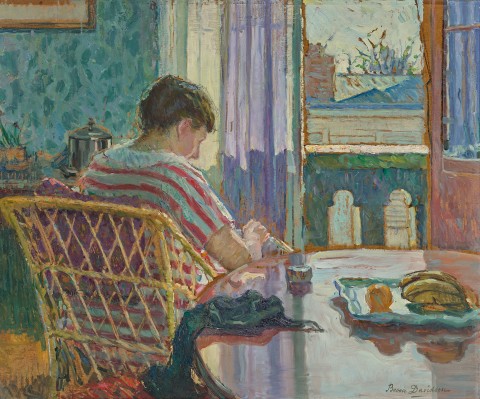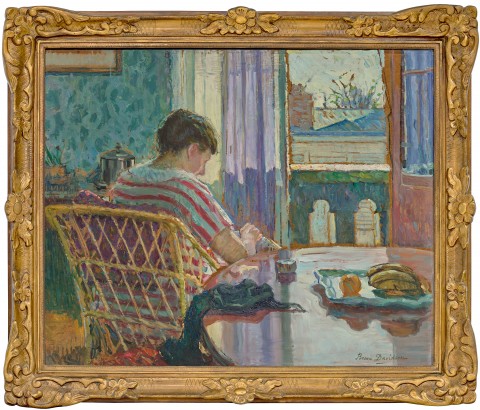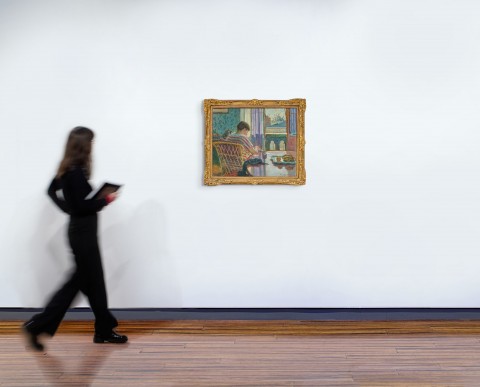(1879 - 1965)
Bessie Davidson
Intérieur, c.1924
oil on board
Salon des Tuileries, Palais de Bois, Porte Maillot, Paris, 1924
Mr & Mrs James P. Cordill, New Orleans, USA, acquired from the above in 1924
Miss Shirley Cordill, New Orleans, USA, a gift from the above
Thence by descent
Private collection, New Orleans, USA
Salon des Tuileries, Palais de Bois, Porte Maillot, Paris, 1924, cat. 409 or 410 (label attached verso)
Intimate portraits of her female friends and their children in domestic interiors make up a significant and arguably the best-known part of Bessie Davidson’s oeuvre. They reflect the influence of Édouard Vuillard (1868 – 1940) and the American, Richard Miller (1875 – 1943), who taught her at Académie de la Grande Chaumière, and perhaps even the art of fellow Australian artist Rupert Bunny (1864 – 1947). Also, and more importantly however, they reflect the fabric and rich detail of her own life and experience as an expatriate in Paris from 1910 until her death in 1965. The settings of these paintings were always familiar to the artist, her own studio apartment in Montparnasse often featured in her work, as did the country homes of friends in rural France with whom she would holiday. As Davidson’s biographer, Penelope Little, has written, ‘The interiors… reveal an ambience of bourgeois refinement, not grand but testifying to lives full of interest and occupation. Furniture is elegant but comfortable, shelves are filled with books and ornaments and walls hung generously with paintings. The many different interiors… reveal something of the lives and personalities of their owners… Bessie’s work celebrated the quiet joys of friendship and domestic activity. Her paintings… are filled not only with her women friends but also with their children, their dogs and cats, their sewing, musical instruments, books and paint-boxes.’1
Painted around 1924, here Davidson depicts a woman focussed on an unidentified task – sewing or perhaps reading – who is seated in the corner of a room. French doors in front of her open onto a balcony and a view to buildings opposite and tree-tops beyond, suggesting it is probably Davidson’s own apartment on Rue Boissonade. It is an informal scene, the figure is simply dressed, a shawl draped casually on the table beside her, and the sparsely filled plate of fruit indicates we are being presented with a glimpse of the everyday rather than a carefully staged view. Using lively brushstrokes Davidson takes pleasure describing the details of the interior, from the striped clothing of the figure to the criss-crossed geometry of the cane chair and the patterned wallpaper. She also grapples with the pictorial challenges of portraying the play of light and shade, skilfully depicting the effects of sunlight shining through the delicate curtains and reflections in the highly polished surface of the table which are recorded in a luscious and painterly application of her medium.
Davidson was active and well-connected within the Parisian artworld and in 1923, alongside Lucien Simon, René-Xavier Prinet and other friends, she was a founding member of the Salon des Tuileries. Formed as an alternative to the existing Salons in an effort to raise the overall quality of exhibited works, entry was by invitation only. Davidson exhibited in the inaugural Salon which, as the name indicates, was held in temporary pavilions next to the Jardin des Tuileries, and she continued to participate in following years.2 This painting was purchased from the 1924 Salon des Tuileries, one of three interiors Davidson showed that year, and has remained in the possession of the same American family ever since.
1. Little, P., A Studio in Montparnasse: Bessie Davidson: An Australian Artist in Paris, Craftsman House, Melbourne, 2003, pp. 64 – 65
2. See ibid., p. 94
KIRSTY GRANT


